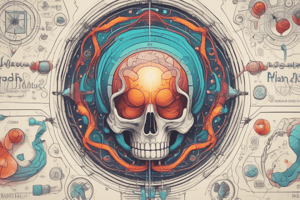Podcast
Questions and Answers
What is the mechanism of action of Tramadol?
What is the mechanism of action of Tramadol?
- Agonizes the Mu opioid receptor while inhibiting reuptake of serotonin and norepinephrine (correct)
- Blocks NMDA receptors
- Acts only as a Kappa agonist
- Inhibits reuptake of dopamine and norepinephrine
Which side effect is associated with Tramadol use?
Which side effect is associated with Tramadol use?
- Bradypnea (correct)
- Hypotension
- Constipation
- Tachycardia
What is a contraindication for using Tramadol?
What is a contraindication for using Tramadol?
- Concurrent use with SSRIs (correct)
- Controlled substance regulation
- Chronic pain over 6 months
- Opioid dependence
What is indicated use of Buprenorphine?
What is indicated use of Buprenorphine?
How should the dosage of a new opioid be adjusted when switching medications?
How should the dosage of a new opioid be adjusted when switching medications?
Which of the following is a potential risk when using Tramadol?
Which of the following is a potential risk when using Tramadol?
In which circumstance is Buprenorphine not recommended?
In which circumstance is Buprenorphine not recommended?
What is the recommended percentage of total daily Morphine milligram equivalents (MME) reserved for PRN dosing?
What is the recommended percentage of total daily Morphine milligram equivalents (MME) reserved for PRN dosing?
What interaction concern exists with Tramadol?
What interaction concern exists with Tramadol?
What is the therapeutic ceiling effect in the context of Buprenorphine?
What is the therapeutic ceiling effect in the context of Buprenorphine?
What is the primary mechanism of action of aspirin in relation to platelet aggregation?
What is the primary mechanism of action of aspirin in relation to platelet aggregation?
Which of the following is a potential side effect of overdose with acetaminophen?
Which of the following is a potential side effect of overdose with acetaminophen?
In what scenario is acetaminophen recommended as a first-line treatment?
In what scenario is acetaminophen recommended as a first-line treatment?
What is the recommended maximum daily dose of acetaminophen?
What is the recommended maximum daily dose of acetaminophen?
Which of the following statements about NSAIDs is true?
Which of the following statements about NSAIDs is true?
What is a contraindication for the use of aspirin?
What is a contraindication for the use of aspirin?
Which of the following parameters may require renal dosing adjustments when using acetaminophen?
Which of the following parameters may require renal dosing adjustments when using acetaminophen?
What is the reason for aspirin's irreversible effect on platelet aggregation?
What is the reason for aspirin's irreversible effect on platelet aggregation?
What is the primary mechanism of action of acetaminophen?
What is the primary mechanism of action of acetaminophen?
Which of the following is an important adverse effect of acetaminophen?
Which of the following is an important adverse effect of acetaminophen?
What is a primary therapeutic use for acetaminophen?
What is a primary therapeutic use for acetaminophen?
What consideration should be made regarding the dosing of acetaminophen?
What consideration should be made regarding the dosing of acetaminophen?
Which of the following conditions should contraindicate the use of acetaminophen?
Which of the following conditions should contraindicate the use of acetaminophen?
In terms of side effects, which of the following is NOT typically associated with acetaminophen?
In terms of side effects, which of the following is NOT typically associated with acetaminophen?
What is a distinguishing feature of acetaminophen compared to NSAIDs?
What is a distinguishing feature of acetaminophen compared to NSAIDs?
Which patient population requires careful monitoring when administering acetaminophen?
Which patient population requires careful monitoring when administering acetaminophen?
Which mechanism of action does NOT apply to acetaminophen?
Which mechanism of action does NOT apply to acetaminophen?
In cases of overdose, which intervention is crucial for patients who have taken excessive acetaminophen?
In cases of overdose, which intervention is crucial for patients who have taken excessive acetaminophen?
Flashcards are hidden until you start studying
Study Notes
Opioid Analgesics
- Morphine is a strong opioid agonist with a high risk of overdose.
- Converting to a different opioid should be done with a 25% to 50% dose reduction to avoid overdose due to incomplete cross-tolerance and individual variability in opioid pharmacokinetics.
- 10-15% of total daily MME (Morphine milligram equivalents) should be reserved for PRN (as needed) dosing.
- Tramadol binds to the Mu opioid receptor and inhibits serotonin and NE reuptake.
- Tramadol should be avoided in patients taking SSRIs due to the risk of serotonin syndrome.
- Tramadol is not approved for use in children and XR products should be avoided in patients with CrCL < 30 or severe hepatic impairment.
- Buprenorphine is a partial opioid agonist/antagonist with a ceiling effect.
- Buprenorphine is not appropriate for chronic pain control.
Non-Opioid Analgesics
- Acetaminophen has antipyretic and analgesic properties, but no anti-inflammatory effects.
- Acetaminophen is thought to inhibit COX-3 in the CNS, reducing prostaglandins and increasing pain threshold.
- Acetaminophen overdose can lead to hepatic injury and the antidote is N-acetylcysteine.
- Aspirin is a potent inhibitor of both prostaglandin synthesis and platelet aggregation.
- Aspirin irreversibly inactivates cyclooxygenase via acetylation.
- Aspirin inhibits platelet aggregation for the life of the platelet, which is 7 to 10 days.
- Aspirin inhibits the synthesis of thromboxane A(2) irreversibly.
Studying That Suits You
Use AI to generate personalized quizzes and flashcards to suit your learning preferences.



